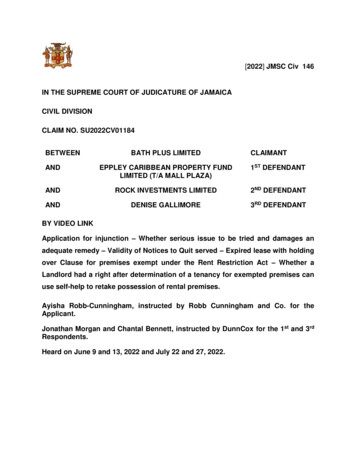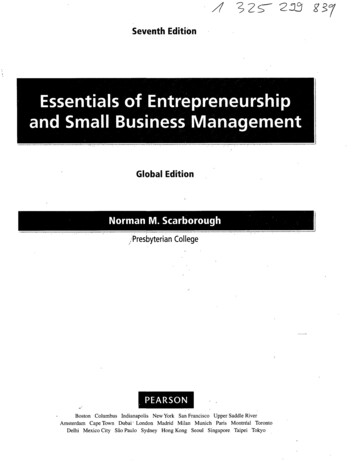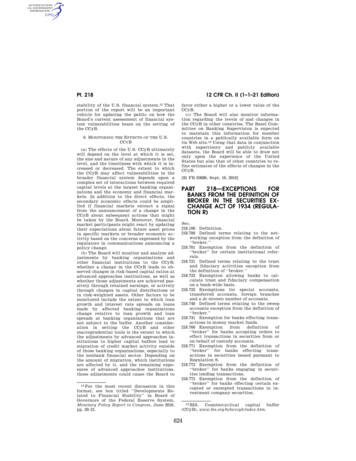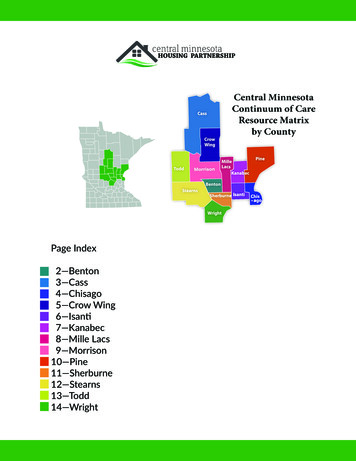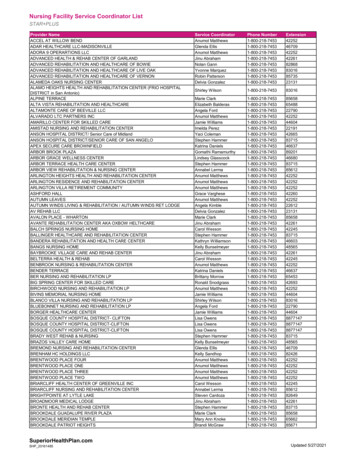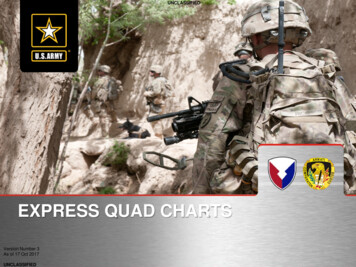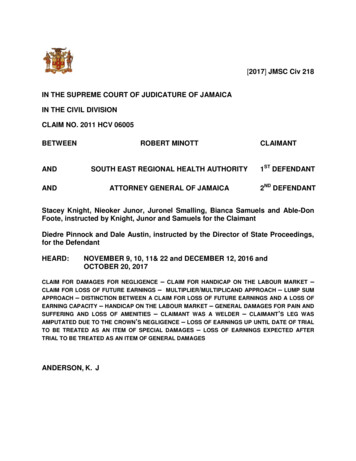
Transcription
[2017] JMSC Civ 218IN THE SUPREME COURT OF JUDICATURE OF JAMAICAIN THE CIVIL DIVISIONCLAIM NO. 2011 HCV 06005BETWEENROBERT MINOTTCLAIMANTANDSOUTH EAST REGIONAL HEALTH AUTHORITY1ST DEFENDANTANDATTORNEY GENERAL OF JAMAICA2ND DEFENDANTStacey Knight, Nieoker Junor, Juronel Smalling, Bianca Samuels and Able-DonFoote, instructed by Knight, Junor and Samuels for the ClaimantDiedre Pinnock and Dale Austin, instructed by the Director of State Proceedings,for the DefendantHEARD:NOVEMBER 9, 10, 11& 22 and DECEMBER 12, 2016 andOCTOBER 20, 2017CLAIM FOR DAMAGES FOR NEGLIGENCE – CLAIM FOR HANDICAP ON THE LABOUR MARKET –CLAIM FOR LOSS OF FUTURE EARNINGS – MULTIPLIER/MULTIPLICAND APPROACH – LUMP SUMAPPROACH – DISTINCTION BETWEEN A CLAIM FOR LOSS OF FUTURE EARNINGS AND A LOSS OFEARNING CAPACITY – HANDICAP ON THE LABOUR MARKET – GENERAL DAMAGES FOR PAIN ANDSUFFERING AND LOSS OF AMENITIES – CLAIMANT WAS A WELDER – CLAIMANT’S LEG WASAMPUTATED DUE TO THE CROWN’S NEGLIGENCE – LOSS OF EARNINGS UP UNTIL DATE OF TRIALTO BE TREATED AS AN ITEM OF SPECIAL DAMAGES – LOSS OF EARNINGS EXPECTED AFTERTRIAL TO BE TREATED AS AN ITEM OF GENERAL DAMAGESANDERSON, K. J
INTRODUCTION[1]On December 26, 2009, the claimant fell into a gully and suffered, as aconsequence, a puncture wound to his right leg. He was taken to the KingstonPublic Hospital and developed gas gangrene which ultimately resulted in his rightleg having been amputated. He filed a claim form and particulars of claim, onSeptember 27, 2011 and claimed damages for personal injuries and financialloss, as a result of the defendants’ negligence.[2]The trial began on November 9, 2016, but on November 11, 2015, crown counselconceded and the parties agreed that liability of the 2 nd defendant was admitted.That was, to my mind, a wise decision on the part of crown counsel. The courtthen entered judgment against the 2nd defendant and proceeded to assessdamages.[3]The parties agreed on the following:a) That the claimant suffered 36% permanent partial impairment, as testified to,by Dr. Philip Waiteb) Taxi fare - 25,000.00c) Claim for prosthesis - 184,800.00d) Cost to repair prosthesis - 35,000.00e) Medical reports of Dr. Philip Waite - 55,000.00f) Medical reports of Dr, D.L. Arscott - 36,000.00g) Cost for disability identification card - 200.00h) Cost for consultation and medical report of Dr. Waite - 107,000.00[4]Upon the assessment of damages hearing, submissions were made by theopposing parties, on special damages, general damages for pain and suffering
and loss of amenities and loss of earning capacity – or in other words and as itwill hereafter be referred to, ‘handicap on the labour market.’ On December 12,2016, however, the claimant’s lead counsel informed the court that the claimantis also seeking damages for loss of future earnings and future medical care,pertaining to replacement of the prosthesis over several years. Those lattermentioned two (2) items of damages are items of special damages, whereas aclaim pertaining to handicap on the labour market, is an item of generaldamages.Special damages claimed for[5]This court accepts and understands it to be the law, that as a general rule,special damages must be specially pleaded and specially proven. In appropriatecases however, where there exists a proper basis to do so, that general rule willgive way to common-sense, which is that in some circumstances, to insist onstrict proof of each and every item of special damages, by means ofdocumentation in particular, would be, as has been stated in at least onereported judgment, ‘the vainest form of pedantry.’ See: Desmond Walters vCarlene Mitchell – [1992] 29 JLR 173; and McGregor on Damages, 12 th ed. atparagraph 1528; and Radcliffe v Evans – [1892] 2 QB 524.[6]That general rule therefore, must to my mind, give way to common-sense, incircumstances wherein, items of special damages are not particularized, but yetthe claimant, during trial, seeks to recover for those alleged losses and thedefendant agrees to permit recovery for same. In circumstances such as that, forall of those items of special damages that the claimant is seeking recovery of, bymeans of an award of damages, since the defendant has consented to theclaimant’s recovery of same, then, even though some of those items were notparticularized in the claimant’s particulars of claim, the claimant ought to be andwill be able to recover for same. If the absence of notice does not perturb theopposing party and thus, the failure to particularize does not perturb that partyand in addition, the opposing party consents to claims for items of special
damages which either could or ought to have been particularized, but which werenot, then the trial court should award same to the claimant.[7]In this claim for special damages, as set out in his particulars of claim, theclaimant had claimed for, inter alia, the cost of obtaining a food handler’s permit 500.00; and the cost of a motorized wheelchair - 249,836.16, and the cost of aspecially adjusted motorcar - 2,000,000.00. All of those aspects of his claimwere subsequently abandoned. They were abandoned by the claimant, duringthe claimant’s counsel’s presentation to the court, of her oral closingsubmissions. They were wisely, in my view, then withdrawn, as either noevidence at all, or no sufficient evidence was led during trial, in support of thoseitems of damages, as were initially being claimed for.The claimant’s claim for ‘loss of income’/loss of future earnings[8]The parties’ counsel, had, at my request, filed and served written submissionsregarding various matters pertaining to the claimant’s claim for damages for lossof income and also, his claim for handicap on the labour market. This court hasread and carefully considered all of that which has been stated therein, alongwith all of the pertinent caselaw, which was appended to those submissions andthanks counsel for same, as they have been helpful to the court. This court hasalso carefully considered the oral closing submissions made on behalf of theparties.[9]As was helpfully elucidated by Harrison, J.A in: Monex Ltd. v Mitchell andGrimes – SCCA 83/96 (judgment delivered December 15, 1998), ‘loss of futureearnings represents a distinctive different set of circumstances where the victimwho, earning a settled wage has suffered a diminution in his earnings onresuming his employment or assuming new employment due to his disability.The net annual monetary loss in terms of the reduction in earnings is easilyrecognizable and quantifiable in such circumstances.’ Thus, as was stated in
Fairley v Thompson – [1973] 3 All ER 677, by Ld. Denning, ‘compensation forloss of future earnings is awarded for real assessable loss proved by evidence.’It is very important to note that, as was stated by Browne J in Moeliker v A.Reyrolle and Co. Ltd. – [1977] 1 All ER 9, ‘As I have said, this problem generallyarises in cases where a plaintiff is in employment at the date of the trial. If he (theclaimant) is earning as much as he was earning before the accident and injury, ormore, he has no claim for loss of future earnings. If he is earning less than hewas before the accident, he has a claim for loss of future earnings which isassessed on the ordinary multiplier/multiplicand basis. But in either case he mayalso have a claim, or an additional claim, for loss of earning capacity, if he shouldever lose his present job.’[10]In some of the caselaw vis-a-vis claims for loss of future earnings, such claimsare set out as a sub-head of the overall special damages items/sums beingclaimed for. In other cases though, such claims are treated with, as an item ofgeneral damages and therefore, are not specifically particularized.[11]What, to my mind, ought to be done as a matter of practice, is to claim for loss ofearnings up to the date of trial, as an item of special damages and toparticularize same accordingly. At the commencement of the trial, the particularsof claim can be amended, to specify what the specific sum of loss has been tothe claimant, in terms of his earnings, from the time of the defendant’s allegedwrong done to him, up until the date when the trial of that claim, has actuallycommenced. That is in fact, a claim for, ‘loss of earnings.’ That is a claim whichis specifically calculable and ought, to my mind, to be specified in the specialdamages particulars, in terms of the precise calculation thereof, once the trial hascommenced.[12]That is not though, what was done in respect of this claim. What was done inrespect of this claim, was that a sum was specified for loss of income and therewas specified, ‘and continuing.’
[13]The ‘continuing’ aspect of that claim for that item of damages is generaldamages, to the extent that beyond the trial date, no one knows what the futurewill bring about. Will the claimant remain alive, once the trial of his claim hasended? What will the economy be like, after the trial has ended? Will there be ashortage or an over-abundance of labour in certain fields of employment, afterthe trial and if so, in what fields of employment will those conditions then exist?All of these are matters of uncertainty.[14]As such, the claim for loss of future earnings, refers to my mind, to a claim foranticipated loss of earnings, after the trial of the claim has concluded.Considered in that context, the claim for loss of future earnings is, in reality, anitem or aspect of the claimant’s overall claim for general damages.[15]I am fortified in my view as expressed above, by dicta from the case earlier citedin these reasons, which for ease of reference, will now simply be referred to as,‘the Monex case.’ Rattray P, who delivered the Court of Appeal’s judgment inthat case, stated, as recorded at page 21, that, ‘it is worthy of note that from thedate in 1991 when the respondent commenced her working life until the date oftrial, real quantifiable losses were sustained, which could have been claimed asloss of earnings, an item of special damages.’[16]In further support of that position of mine, I refer to paragraph 35-061 of the text –Mcgregor on Damages, 18th ed., 2009, where the following is stated: ‘Theclaimant is entitled to damages for the loss of his earning capacity resulting fromthe injury; catastrophic injuries, where cost of care predominates, apart, thisgenerally forms the principal head of damage in a personal injury action. Bothearnings already lost by the time of trial and prospective loss of earnings areincluded. While the rules of procedure require that the past loss be pleaded asspecial damage and the prospective loss as general damage, there wouldappear to be no substantive difference between the two (2), the dividing linedepending purely on the accident of the time that the case comes on for hearing.Thus it has been accepted that the rule in British Transport Commission v
Gourley in relation to the incidence of taxation applies equally to the loss ofincome till judgment and the loss of earning capacity in the future. Similarly, thecourts must take account of relevant changes of circumstances occurring beforeand after judgment, the only difference being that the former are a reality and thelatter a matter of estimate. However, interest is to be awarded on the past lossbut not on the prospective loss of earnings.’ See: Jefford v Gee – [1970] 2 QB130.[17]British Transport Commission v Gourley – [1956] AC 185, is authority for theproposition, as stated by the author in his quotation above, that, ‘the rules ofprocedure require that the past loss be pleaded as special damage and theprospective loss as general damage’. See per Ld. Goddard, at 206.[18]As stated at paragraph 35-065 of the same text, ‘the courts have evolved aparticular method for assessing loss of earning capacity, for arriving at theamount which the claimant has been prevented by the injury from earning in thefuture. This amount is calculated by taking the figure of the claimant’s presentannual earnings less the amount which he can now earn annually, andmultiplying this by a figure which, while based upon the number of years duringwhich the loss of earning power will last, is discounted so as to allow for the factthat a lump sum is being given now, instead of periodical payments over theyears. This latter figure has long been called the multiplier; the former figure hascome to be referred to as the multiplicand. Further adjustments however, may ormay not have to be made to multiplicand or multiplier on account of a variety offactors, namely the probability of future increase or decrease in the annualearnings, the so-called contingencies of life and the incidence of inflation andtaxation.There are, exceptionally, situations in which the court is entitledbecause there are too many imponderables in the case, to regard thisconventional method of computation as inappropriate and to arrive simply at anoverall figure after consideration of all the circumstances.’South Cumbria Health Authority – [1993] P.I.Q.R Q1.See:Blamire v
[19]Applying my understanding of the law as regards a claim for, inter alia, ‘loss offuture earning,’ to the circumstances of this claim, I must at this stage primarilyfor the benefit of those persons who are reading this judgment, set out the factsunderlying this claim and as regards the consent judgment as to liability, whichhas now been entered by this court, in respect hereof.The background[20]The claimant’s evidence was that he is a skilled welder and that on December26, 2009, while he was sitting on a chair near the gully, that chair broke and as aresult, he fell into the gully and the broken chair then fell on him, resulting in apuncture wound to his right leg.[21]The claimant was, as a consequence, in pain and was taken to the KingstonPublic Hospital for treatment. Upon his arrival at the Kingston Public Hospital,the claimant was not given immediate attention. He had to register before hewas treated and that registration process took approximately thirty (30) minutes.It was only after he had been registered that he was taken to the casualtydepartment, where his wound was cleaned and he received an injection for thepain.[22]The claimant was then taken to the waiting area, where about six (6) personswere ahead of him. At that time, despite the injection that he had been given, theclaimant remained in pain and his wound was bleeding very badly.[23]The claimant had to wait until the doctor on call had returned from lunch and thesix (6) other persons had been attended to, before he was attended to, by thatdoctor on call. By that time, the claimant had been in severe pain for about four(4) hours. The surface of the wound was then cleaned and the wound stitchedup and drugs were prescribed.[24]The claimant returned home at approximately 4:00 pm that day, when he noticedthat his wound was still bleeding and that he was in even more pain than before.
The claimant also noticed that the blood from the wound was darker in colourthan before. The claimant did not take any of the prescribed medicationsbecause the pharmacies were, he testified, all closed on that day.[25]By 11:00 pm that night, the claimant was in terrible pain, it was worse than it hadbeen before and the claimant returned to the Kingston Public Hospital at about11:30 pm. The claimant then was admitted to ward and given an injection for hispain. That injection did little to help ease the pain and thus, soon after, theclaimant pleaded for assistance. At that time, the claimant observed that therewere multiple doctors and nurses on the ward.[26]The claimant’s wound was bleeding very badly and he was then in so much painthat he was crying. That notwithstanding, the claimant was left in that state ofterrible pain and received no further treatment until the afternoon of the followingday.[27]The claimant was attended to, by a doctor, during that following afternoon, whichwas December 27, 2009. That doctor only cleaned the defendant’s wound andthen instructed a nurse to bandage the wound. The claimant was then sent backto bed. During the following day – December 28, 2009, the claimant wasapproached by three (3) doctors, who then told him that he needed to havesurgery to remove infected tissues and that if it was a drastic situation, then hisleg would have to be amputated.[28]The claimant underwent surgery and awoke to find that his leg was amputatedbelow the knee. On the following day, the claimant was once again, medicallyassessed and was then told that there were bubbles gathering in his leg and thathe would have to undergo a second surgery. The claimant underwent thatsecond surgical operation and later, awoke to find that his leg was nowamputated above the knee.
[29]Other testimony given during the trial, by the defence witness – Dr. RichardAitken, made it clear that the claimant had, while undergoing treatment at theKingston Public Hospital, for his initial injury, developed a medical conditionknown as, ‘gas gangrene,’ as a result of which, his leg had to be amputated.[30]It was the claimant’s contention as to liability, that if he had been treated in atimely and/or reasonably skilful manner by the hospital staff – Crown servants oragents, gas gangrene would either not have developed at all, or, at least, wouldnot have developed to the extent that amputation became necessary.[31]The Crown, as represented for the purposes of this claim, by the AttorneyGeneral, eventually accepted that contention and therefore, at that stage, aconsent judgment as to liability was entered by the court, against the 2 nddefendant.[32]That which has been set out above, in detail, as to the factual scenario, in termsof evidence presented to this court during trial, has been accepted by this courtas being both accurate and truthful, save and except in one respect, which is, aswas testified to, by Dr. Aitken and accepted as also being both accurate andtruthful, by this court. That is that, when the claimant was initially treated at thehospital, prior to his having initially left there, he (the claimant) was prescribedoral antibiotics. There was no evidence given to this court by anyone, to evenremotely suggest, either that the claimant purchased that medication, or had itpurchased for him, much less that he had actually ever commenced taking same,in an effort to improve his health at that time.[33]Somewhat surprisingly though, the defendant had not alleged contributorynegligence on the part of the claimant, in the cause of his loss of his leg andconsequential financial loss. As a consequence therefore, the defendants werenot able to rely on same. See: Section 3 (1) of the Law Reform (Torts) Actand Fookes v Slaytor – [1979] 1All ER 137.
[34]Solely for the sake of completeness in enabling a proper understanding of thefacts underlying this claim, it should be stated, as it was in evidence, by Dr.Aitken, that, ‘though uncommon, gas gangrene is a highly virulent andaggressive infection as exemplified in this case.Based on the clinicalobservation made during the wound exploration and the rapidity of the infection,an amputation had to be done to salvage the life of the claimant.’ (paragraph 19of Dr. Aitken’s witness statement)[35]It is worthy of note that in very large measure, the claimant’s evidence givenduring trial and as recounted above, was unchallenged by defence counsel andtherefore, was treated with, by this court, as having been accepted by thedefendants.[36]Whilst a particular witness/litigant though, may have been truthful in the giving ofevidence during a court proceeding, at least in terms of the evidence which heactually gave to the court, that does not mean that said witness has told thatcourt, the whole truth. Sometimes, things/details left unsaid by a witness are ofjust as much importance to understanding and knowing everything which needsto be known by the fact – finding tribunal/Judge, in order for that fact – findingtribunal/Judge to make a fair and properly reasoned assessment of how allpertinent issues in that case, ought to be legally resolved, as is the evidenceactually presented to that tribunal/Judge, in that case.The analysis of the claim for loss of income/future earnings[37]The claimant has, in his particulars of claim, itemized as an item of specialdamages, his claim for loss of future earnings, as follows: ‘loss of income for 18months and continuing 1,152,000.00.’[38]Accordingly, by using the words, ‘and continuing,’ it is apparent that the claimantis, in respect of that item of his overall claim, seeking to recover for actual loss,as well as anticipated loss. The actual loss of income will, if it is awarded at all,
be awarded to compensate the claimant for loss of income from the time of histreatment at the Kingston Public Hospital, up until the date of judgment on theclaim – as that is when the trial of the claim would have concluded.[39]The anticipated loss, which is that which, to my mind, can properly becategorized as, ‘loss of future earnings,’ would pertain to the anticipated incomelosses of the claimant between the time, post-trial and his expected date ofretirement, based upon evidence as to his date of birth or, at the very least, hisage at the time when trial was underway. That anticipated loss is typically to becalculated using the multiplier/multiplicand method and no interest is payable onany damages sum awarded in respect of such anticipated loss. On the otherhand though, interest is to be awarded, in respect of the claimant’s actual loss ofincome.[40]The claimant’s lead counsel – Ms. Stacey Knight, had strongly contended, bothorally and in writing, that the claimant is entitled to recover for loss of income,both in terms of his past, or in other words, actual loss as well as his anticipated,or in other words, future loss. Counsel – Ms. Knight, has not though, at all timesremained consistent in her contentions in that regard.[41]It was her contention that in Jamaica, just at it is in England and Wales, themultiplier/multiplicand approach is the typical and also, preferable means, ofcalculating loss of future earnings.See: Ward v Allies and MorrisonArchitects – [2012] EWCA Civ 1287, at paragraph 20, per Aitken LJ; andKenroy Biggs v Courts Jamaica Ltd. and anor. – Claim No. 2004 HCV 00054;and Curlon Lawrence v Channus Block and Marl Quarry Ltd. and anor. –[2013] JMSC Civ 6 and The Attorney General v Phillip Granston – [2011]JMCA Civ 1.[42]In England, the ‘Ogden tables’ are used to determine the multiplier. Those areactuarial tables created by a team of experts in the United Kingdom and whichpertain to persons who live there. Since that cannot be usefully applied in
Jamaica, what is done here, is that the court draws its conclusion as to theappropriate multiplier, by considering the expected retirement age and adjusting,depending on the claimant’s age at the time of the injury/tort and the nature ofthe claimant’s disability and the vicissitudes of life.[43]As stated by the claimant’s attorneys in written submissions, ‘when determiningthe multiplicand, that is, the annual loss of earnings, it is required that the courtfirst settle on what is the likely pattern of employment and earnings that theclaimant would have had if it were not for the tort. Then the likely pattern ofemployment and earnings in the circumstances of the case is decided, in order todetermine the loss.’ See: Ward v Allies and Morrison Architects (op. cit.); andLeesmith v Evans – [2008] EWHC 134.[44]Thus, to determine both actual loss of earnings and loss of future earnings, it isvery clear that what must be provided to the court, first and foremost, is evidenceas to the claimant’s earnings up until the time when he either ceased altogether,to earn at all, any income, or alternatively, ceased to earn as much income as heor she used to earn, prior to the commission of the tort, in relation to him, by thedefendant.[45]What was the evidence, if any at all, in that regard, will shortly hereafter beaddressed. Prior to addressing same though, it is worthy of note at this juncture,that it is the claimant’s counsel’s submission, that the claimant’s pre-accidentearnings was 37,272.50 per fortnight (every two weeks).[46]On the other hand, the defence counsel have in writing, submitted that thereexists absolutely no evidence from the claimant as to his having in fact beenearning an income, immediately prior to the accident, or in other words,immediately prior to his having been taken to hospital as a consequence of theaccident, which is where the tort in relation to him, was committed by the Crown,as represented by the 2nd defendant.
[47]Following on that submission, it is also the defence counsel’s submission that noaward should be made to the claimant, for loss of earnings, whether up until thetime of trial, or after the trial has concluded.[48]That written submission was made after the oral closing submissions had endedand after this court had ordered the parties’ counsel to provide to the court and toopposing counsel, written submissions on various issues pertaining to theclaimant’s claim for, ‘loss for income for 18 months and continuing,’ which is whattheir lead counsel has termed as a claim for, ‘loss of future earnings.’[49]During the parties’ oral closing submissions, which this court has given carefulconsideration to, during the claimant’s lead counsel’s initial presentation/makingto this court of that submission, the claimant’s lead counsel had, initially,specifically stated that the claimant is not claiming for loss of future earnings.Upon the continuation of her oral closing submissions however, which took placeon a separate date from the date when those submissions began, Ms. Knightmade it clear to the court that the claimant is in fact claiming for loss of futureearnings, separate and apart from handicap on the labour market. She then toldthe court that any suggestion to the contrary earlier made by her, was made inerror and is therefore incorrect.[50]It is now, therefore, very clear that the claimant is claiming for loss of futureearnings, in addition to and as a separate head of damages, from handicap onthe labour market.[51]In her oral closing submissions on that latter date, Ms. Knight submitted that six(6) payslips are in evidence for the claimant, arising from his employment until2007. She is correct in terms of her restatement of the evidence in that regard.It is to be recalled though and it is of importance to note that, the incident whichled to the claimant having been taken to the Kingston Public Hospital on thatsame day, occurred on December 26, 2009. It was the negligent treatment of theclaimant, at that hospital, which has led to this claim.
[52]Ms. Knight went on to contend, that the median/average of those six (6) payslips,is 37,727.08 and that the claimant’s annual income in 2007, would have been: 850,904.17.Her submission is that said sum ( 850,904.17) represents themultiplicand. The multiplicand, it will recalled, as was submitted in writing, by theclaimant’s counsel, should be the earnings that the claimant would have had, if itwere not for the tort. I have corrected that submission somewhat though, bystating earlier in these reasons, that the multiplicand is the earnings that theclaimant would likely have had, if it were not for the tort. That must be so, sinceno one can predict the future with certainty.[53]In her oral closing submission, Ms. Knight submitted that the multiplier to beused, is 13. The claimant’s counsel maintained that submission, as part andparcel of their written submissions.[54]Accordingly, it is the claimant’s counsel’s submission, that the sum of 850,904.17 (the multiplicand) is to be multiplied by the multiplier of 13, thusgiving a total of 11,061,754.20 – which is the sum that is now being claimed bythe claimant, for loss of future earnings.[55]The claimant’s evidence as to his date of birth, is that he was born on March 6,1981 and that he is a welder. That evidence has been accepted by this court asbeing both accurate and truthful.[56]The claimant’s evidence went further as to his training as a welder, hisemployment in 2007, his unemployment between 2010 and 2013 and what hasbeen his employment status since November, 2013. It is worthwhile to recountthat evidence in some detail and that will be done, immediately hereafter.[57]He gave evidence that he is a skilled welder and that he has a level 2 weldingcertificate from the Heart Trust (NHT), a National Contract Certificate in Weldingand a pass, as an American Welding Society (AWS) test result.
[58]He also, gave evidence that, ‘back in 2007,’ when he, ‘was at Carib Cement,’ he,‘used to earn almost 30,000.00 per fortnight, but from 2010 until the end of2013,’ he was unemployed. During those four (4) years, he had to take groceriesand other necessary goods, on credit. He was doing odd jobs like selling booksto pay his bills, but there was no profit in that.[59]There were entered into evidence, at the onset of the trial, several agreeddocuments. Among those documents were payslips from Schrader, Camargo,Ingenieros – the parent company for Carib Cement. Those were the payslipsgiven to the claimant by his then employer and are payslips issued every two (2)weeks (fortnight). They are respectively dated as follows: March 2, 2007, March16, 2017, March 30, 2017, April 13, 2017 and May 11, 2017.[60]No enquiry was made of him, by either lead counsel at trial, on behalf of eitherparty, as to the whereabouts of any of the other payslips which he should have, ifhe had continued working at Carib Cement until he had become injured and beentaken to the hospital, on December 26, 2009.[61]It is not surprising though, that defence counsel would not have asked thatquestion, because lead defence counsel is to my knowledge, sufficientlyexperienced as an attorney, to know that when cross-examining a witness, it is astrong general rule, that one should never ask a question in respect of w
Fairley v Thompson - [1973] 3 All ER 677, by Ld. Denning, 'compensation for loss of future earnings is awarded for real assessable loss proved by evidence.' It is very important to note that, as was stated by Browne J in Moeliker v A. Reyrolle and Co. Ltd. - [1977] 1 All ER 9, 'As I have said, this problem generally arises in cases where a plaintiff is in employment at the date of .
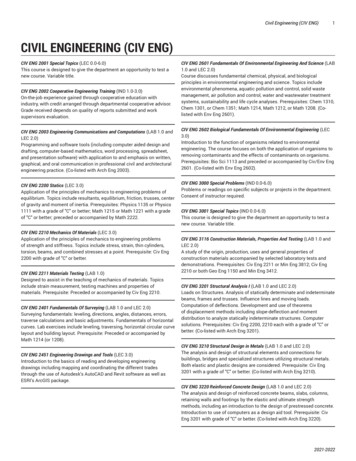
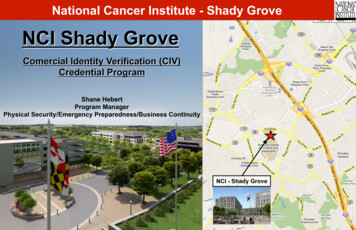
![[2020] JMSC Civ 37 IN THE SUPREME COURT OF JUDICATURE OF JAMAICA IN THE .](/img/22/neil-2c-20george-20v-20the-20attorney-20general-20of-20jamaica-2c-20office-20of-20the-20utilities-20.jpg)
